Story Nine - Fishing for Clues | |
| Story One | Story Two | Story Three | Story Four | Story Five | Story Six | Story Seven | Story Eight | Story Nine | Story Ten | |
| Visit the main River Returns web site >> | |
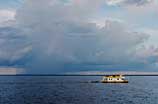 |
The Native Americans' name for the St. Johns River was Welaka, which translates to River of Lakes. Here, one of the River Returns film crew's houseboats makes its way across Lake George, the biggest bulge in the center of this river, on its way upstream toward Lake Jesup. |
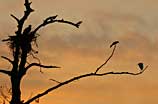 |
As the sun rises over Lake Jesup, it backlights the bare branches of a popular perch that's occupied simultaneously by an osprey, a grackle, and an egret. |
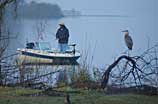 |
Heedless that it's the most polluted lake in the St. Johns River system, a fisherman ventures out onto Lake Jesup at dawn to try his luck. Scientist Jim Gelseichter, who conducts research on this lake, says that he would not eat anything caught here. |
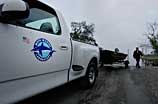 |
Jim Gelseichter arrives at Lake Jesup after driving from Sarasota, where he works for Mote Marine Laboratory. Jesup is the site of a long-term study of stingrays in the St. Johns River, the objective of which is to compare various sites in terms of impacts from pollution on the river's stingray population. |
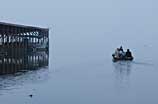 |
A heavy fog blankets Lake Jesup and has yet to lift as the crew heads out to an established fishing site where Jim frequently sets trot lines to catch stingrays. |
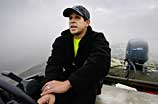 |
Jim Gelseichter, a scientist from Mote Marine Laboratory in Sarasota, Florida, has a lot of respect for St. Johns stingrays, saying, "They are as tough as you get." Jim's pretty tough himself, spending hours at a stretch hauling in trot lines in order to catch research subjects. |
 |
After catching the stingrays -- no easy feat -- Jim will measure and weigh them. He intends to keep five females for tissue samples and throw back the males after tagging them. |
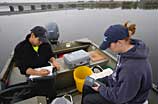 |
Jim and an assistant from Mote Marine Laboratory measure the temperature, salinity, and oxygen level of the water in Lake Jesup. The stingrays here live in fresh water for their entire lives. |
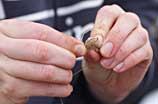 |
To maximize his chances of catching a good number of research subjects, Jim uses a long trot line with dozens of baited hooks that he anchors to the bottom of Lake Jesup and lets sit for an hour at a time. |
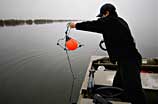 |
Photo of Jim setting the trot line |
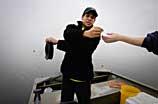 |
As his boat slowly idles forward, Jim lets out the trot line and attaches a baited hook, one about every 10 feet. |
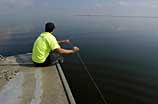 |
By early afternoon, the sun has burned through a stubborn fog and Jim's on his third pull of the trot line, with no luck. All attempts to hook a stingray this day have been futile despite that Lake Jesup, according to Jim, is "lousy with stingrays." |
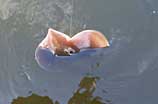 © Mote Marine Laboratory |
A St. Johns River stingray living in Lake Jesup finally takes a bit of shrimp bait and gets itself hooked into a research study involving pesticides and hormones being conducted by Jim. |
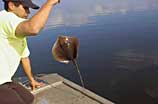 © Mote Marine Laboratory |
It's a boy! Jim Gelseichter pulls up the first -- and only -- catch of the day after many long, hot hours of fishing for stingrays in Lake Jesup on the St. Johns. It's unusual not to catch more rays during an outing and Jim will have to return to the lake to accomplish his goal of catching five females for his ongoing research. |
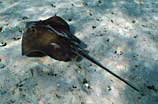 |
Stingrays can be found up and down the length of the St. Johns River. Some are easily seen, like this one swimming in the clear water above the white sand bottom of Silver Glen. Others, such as those living in mud-bottomed Jesup, remain camouflaged in the tannic water and hidden under a surface coating of algae. |
Water's Journey
The River Returns
Stories of the Great St. Johns
The River Returns web documentary, Copyright © Fusionspark Media, Inc. All Rights Reserved.
All Photos © 2005 Russell Sparkman/Fusionspark Media, Inc., unless otherwise noted.
All Photos © 2005 Russell Sparkman/Fusionspark Media, Inc., unless otherwise noted.
